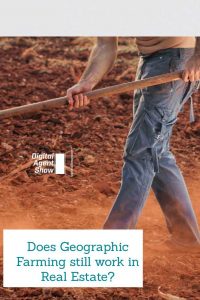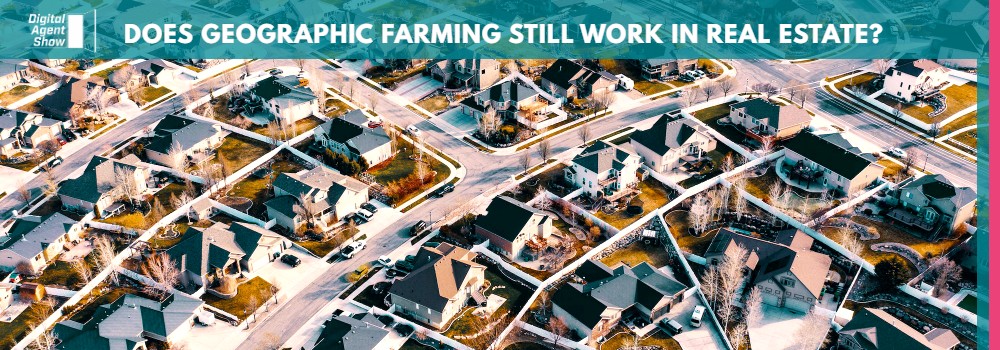Does Geographic Farming still work in Real Estate?
One of the ways to grow and establish your real estate brand in an area is by geographic farming. By understanding your clients and nurturing relationships, you develop a consistent pipeline of seller and buyer prospects. But does geographic farming still work?
Geographic farming still works in real estate. It is an effective lead generation method and is a practical approach as a long term marketing strategy. Your goal is to ultimately brand yourself as the real estate expert of a particular area or neighborhood.
The rest of this article will explain a few topics related to this question in great detail, including what geographic farming is, why agents use it, and some methods to launch your next geographic farming marketing campaign in your neighborhood.
What Is Geographic Farming?
Geographic farming is a lead generation method for prospecting in a particular area. The real estate agent commits to a specific area or neighborhood and connects directly with homeowners and the overall community to nurture relationships.
This is a very long term approach involving consistent messaging and community involvement. As you start to nurture relationships, your real estate business and commitment to a particular area will constantly be kept at the forefront of everyone’s mind.
For a closer look at geographic farming, first, you identify homes in an area that would become candidates for sale in the near future. These are the seeds of potential transactions. These seeds are then nurtured by establishing a close relationship with these homes’ owners in your geographic farm area.
By regularly communicating your business and taking part in community events, the more you become a household name and the go-to person when it comes to real estate buying or selling. When the owners are ready to commit to selling their houses, you are ready to collect and harvest these sales.
Geographic Farming Advantages and Disadvantages
It is important to choose a place where you already have some experience being a part of a community, such as the neighborhood you live in. The advantage is that you can share the fact that you live there, making it easier for residents to trust you as the local expert. You will be able to discuss local issues and tie in the fact that you know what it feels like as a homeowner in the area, which will raise your trust level in the eyes of the homeowners.
Geographic farming can be very tedious and labor-intensive. It requires a lot of marketing and coordination, knocking door to door, managing a direct mailing list database, or event management.
However, establishing branding in your neighborhood makes it easier to get referrals in that area. Having the inside scoop and personal knowledge of each property’s owners gives you an advantage over agents that only of the neighborhood from online research.
Besides being labor-intensive, another disadvantage to geographic farming is that it requires some initial capital to get started. Some of the lead generation marketing campaigns involved with geographic farming are not free. While it does not have to be super expensive, it still requires some money to start. However, investing now will only help you reap the rewards later.
Keep in mind that this is a long term strategy, and you will most likely not be able to see the benefits of geographic farming in an area until months later.
What Are Some Ways to Geographic Farm an Area?
Every marketing material or message you send out must consist of some value to the people receiving it. Commit to delivering regular content for approximately a year, as some real estate agents report seeing a positive return on investment from their geographic farming campaign initiatives after approximately 12 months of marketing.
Ensure that every piece has a call to action to nurture prospects down your marketing pipeline and ensure messaging is consistent across all marketing collateral. The following are some ways you can start canvassing and launching marketing campaigns in your geographic farm area.
Mailers
Mailers such as postcards are a great way to send information on the real estate market to your chosen geographic farm area. According to the 2018 statistics from the Association of National Advertisers Data Marketing & Analytics, approximately 52.5% of postcard mailers’ potential recipients claim they will read it. A letter envelope will only be opened in approximately 0.34% of cases.
This shows great potential for your mailing base to actually read the mailers you send without being immediately thrown into the trash. Each postcard you send should be visually attractive to hold people’s attention, so hire a graphic designer to design beautiful postcards. You can also retain a professional photographer who can take photos of amazing visuals rather than relying on the camera on your cell phone.
On the postcards itself, you can write an overview of every quarter of the neighborhood real estate market or other fun options such as baked goods recipes or the latest sports schedule. Provide value so that people will not throw away your mailers but rather post it up on their kitchen fridge.
You can also include mailing items such as ice cream scoops with your realtor contact information or water bottles. This type of branding works because people are more likely to keep the tool and use it rather than throwing it away. Every time they use the ice cream scoop, they will see your contact information and remember your real estate business.
These types of marketing products do not necessarily have to be expensive, as you can buy them in bulk for a lower price. While it does require some money upfront, it is best to consider it as an investment towards nurturing relationships with the homeowners in your area. These mailers are a great way to keep you at the forefront of everyone’s mind.
Always add a professional headshot in your mailers to set you apart from other real estate agents in the market. People will be able to recognize you when you follow up in person or when you get involved in community events. If people do end up posting it on the fridge, your face will be memorable. When other people visit the homeowner’s house, they will also see your postcard, and your reach will expand exponentially.
Since it is illegal in almost every state in the United States to solicit listings when it is already offered to another real estate broker, protect yourself with a legal disclaimer on your mailers like the one below:
“If your property is currently listed with a realtor, agent, or broker, please disregard. It is not our intention to solicit the offerings of other real estate brokers. We are happy to work with them and cooperate fully.”
While the previous statistic from the Association of National Advertiser’s state that postcards are more likely to be opened than letters, sending letters is a great way to connect with the homeowners in your geographic farm. Since postcards have limited space, letters are a fantastic method to prospect because there is more space to go in-depth to discuss the local real estate marketplace.
In your letters, you can also include any community shoutouts or other local information that proves to be valuable to your mailing list. This will show that you are the expert in both the overall community and the local real estate market.
Most importantly, take the opportunity to personalize your direct mailers. In 2015, Gallup noted that 41% of Americans looked forward to checking their mailbox to see what was delivered each day. Specifically, over 90% of Americans said they had a positive reaction when they received personalized letters and cards.
Personalization can include your mailing recipient’s first names or pictures of a local area they would recognize. If you are multilingual, you can also print the same postcard in a different language to adjust depending on your homeowners, which helps you appeal to a wider audience. You can also add a QR code to the mailer for tech-savvy individuals who are more likely to scan a code for your contact details rather than keeping your postcard.
Try to avoid pushing a sales pitch too hard in your geographic farm area because you do not want to be seen as an annoyance. Rather, your goal is to be a real estate expert in the neighborhood and have people refer to you for assistance.
Door to Door
The best way to make people realize and recognize who you are is to meet you. One of the ways to get seen in your community is to knock on doors and do door-to-door introductions about who you are and your real estate business. While you might run into rejection and awkward moments, these people have been receiving your mailers consistently and will hopefully know who you are.
Try to go out about once a year to personally introduce yourself and hand out business cards, especially in the “seed” houses where you think the owners are ready to sell. Rather than just simply pushing your practiced sales pitch, try to offer something of additional value, such as an invitation to a community event or an open house nearby. Your goal is to start a conversation, learn more about the homeowner, and make a connection rather than a sales call.
Going door to door does not necessarily have to involve knocking, as you can print outdoor hangers to hang on the door handles of each home. You can deliver them yourself by walking to each property or partner with a company to have them hung on each door.
If you do deliver them yourself, more often than not, you will most likely bump into residents in the area and can start up a conversation. This is a soft lead rather than a more intrusive door to door knocking campaign and can be less intimidating for real estate agents.
But these door to door hangers may not work if they do not add value. You do not want to cause a negative response to your door hanger campaign and be reported as a nuisance in your area. Even worse, being labeled as a neighborhood annoyance is one way to get your brand value to drop.
Avoid this by including magnets or notepads in the door hanger or various coupons for local businesses that would be beneficial to the homeowners on your mailing list. Neighborhood businesses are more likely to work with you and extend a special offer as they also want to expand their reach! Adding these items gives more immediate value to the homeowners and ensures that you will not be seen as a nuisance.
Ultimately, put yourself in the homeowner’s shoes to see what is most helpful to them.
Events
Real estate agents that hold events in the community have more of an impact. Families are constantly on the hunt for free activities that are family-friendly and often have a large community network.
By tapping into sponsoring family-friendly activities such as a pumpkin carving event or Santa Claus photo session, you expose your business to these community networks, which will help referrals flow into your real estate prospect pipeline.
Other events include hosting tailgates at local sports team games or holding a charity event. Charity events are one of the most popular events to host as it brings people together to give back to the community.
When it gets colder, try holding a charity drive for winter jackets to donate to the Salvation Army or other nonprofits. Some foundations have a program such as the Salvation Army Real Estate for Rehabilitation, which provides marketing material specifically for real estate realtors.
They provide easy tools and free postcards or brochures for easy donation pickups for gently used clothing. Make sure that all the marketing material you spread also has your marketing and contact information.
By now, you probably have a sense of what charity your neighborhood would most likely want to donate towards, so choose a cause that will not alienate a part of your neighborhood.
The more you spread the marketing material and information about the charity drive, the more residents in your area will notice that you care about more than simply just your business. This strengthens your overall branding as people notice that you consistently give back to the community.
Offer a sweet giveaway for everyone that donates to the cause, such as free hot chocolate and cookies. The event allows you to hand out delicious refreshments while touching base and connecting personally with all the prospects in the real estate geographic farm.
To also expand your reach online, publicly promote the event on social media to other people in the community who may not have been aware of your business. With enough time, your reach can expand outside your initial farm area as people outside the community get referred to your real estate business.
Community Yard Sale
Real estate agents can also sponsor community events rather than hosting an event. Become an essential part of community events by offering to pay for all the advertising and signage, give away water to each person, or sponsor a cost of a food truck to park at the community yard sale for free food.
Taking over the advertising for a yard sale helps you because not only can you print signs, but you can also run ads in the online and local newspapers along with local Facebook groups that will expand your reach.
Community yard sales or neighborhood markets are usually held regularly. As consistency is crucial in establishing a brand, the more often you participate in these community sales and launch free giveaways, the more likely the residents will look forward to you being there!
People enjoy community yard sales because it turns a simple sale concept into a community bonding event. Residents that do not necessarily have anything to sell or buy will still stop by to see if there is anything available that is a good deal.
It is also easier to manage the flow of traffic, and you can meet each person individually as residents will come randomly rather than all at once. This allows you to introduce yourself and connect with the community.
Conclusion
Geographic farming requires selecting an area to launch multiple marketing methods to develop a pipeline of leads. While it is a long term approach and can take months to see the results of your lead generation campaigns, geographic farming still works in real estate. It is very effective in developing and nurturing relationships within a community.

As a real estate agent, it is essential to keep providing value and stay on top of your client’s mind by consistently keeping in contact, whether through mailers or events. You want potential sellers to know who you are and see your face, so they come to you when they are ready to sell.
As people begin to recognize you and trust your skills in the marketplace, the more likely they will refer to you as the local real estate expert and come to you for assistance.







